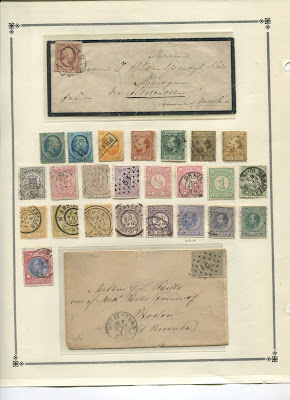Dutch stamps abound in feeder albums, so filling the
Netherlands spaces in Big Blue isn’t difficult except, perhaps, for a few of
the postage dues. Nevertheless, I always check the Netherlands pages for
interesting cancels when I get a new feeder album. Like its neighbors, Belgium
and Luxembourg, the Netherlands excelled in SON (socked on nose) cancels during
the pre-World War I era, and I’ve always liked them.
At first, I traded my ordinary cancels for any with clear
dates and places of origin. Some of these linger on the first pages of the
scans shown below, also on the supplement pages. Then, as duplicate SONs amassed,
I limited my replacements to stamps cancelled in the towns I visited in
pre-covid days. These also, in part, linger.
More recently I’ve been scanning the feeders for
town-cancels where medieval, renaissance, and impressionist Dutch artists were
born -- Hertogenbosch for Hieronymus Bosch (b. circa 1450), for instance, or Leiden
for Rembrandt (b. 1606). These make for a somewhat more difficult search. I
haven’t gotten very far but they, too, are plentiful. Dutch towns have long
histories of supporting the arts. If, however, I end up finding too many of
these, I’ll try birthtown cancels pinked on the artists’ birthdays. So far, I’ve
found none of these. I might someday find and keep, say, a 17 June 1898
Leeuwarden cancel, M. C. Escher’s birth date and town. Who can guess what
surprises feeder albums may hold?
For instance, take the Scott #84 (shown below). Cancelled
in Bosch’s hometown, it’s supposed to be brown lilac, but gray lilac describes it
better. An anomaly? Chemically faded? A rarity? I like it simply for its
Hertogenbosch cancel. Peeking from behind it is a normal brown lilac #84, also rescued
from a feeder album.
I’ve had more luck
finding cancels for Hertogenbosch than for any other artist’s birthtown. Here are three more:
Roughly contemporary with
Bosch is the master engraver known only as IAM of Zwolle, the town of Zwolle
presumably being where he was born and worked. While little is known about
Bosch personally, even less can be said about IAM. His surviving works, only 24 in all, feature swarming crowds,
have fine tonal nuances and, like Bosch’s paintings, tend toward the grotesque.
The Zwolle postmark is
“type 75” according to O. M. Vellinga’s Postmarks of the Netherlands
1676-1915, a comprehensive on-line resource: https://jdlkremer.angelfire.com/VELLINGA.1676-1915.KNBF.pdf.
Leiden postmarks (Rembrandt’s place of birth) are also rather easy to come by. Rembrandt, of course, is not only the greatest Dutch artist, but the world’s greatest. I’m struck by the similarity of Queen Wilhelmina’s profile on the two stamps shown below and that of Rembrandt’s Bathsheba, except Bathsheba, having received King David’s letter demanding an illicit tryst, carries a mien of deep sadness.
Coded
postal obliterators (CPOs; puntstempels in Dutch) provide another way to
identify artists’ hometowns although place names are not spelled out. A number,
surrounded by 26 variously-shaped dots, designates the post office of origin (5
= Amsterdam, 91 = Rotterdam, and so forth). It’s unusual for all 26 dots to
print and, even more rare, for all 26 to be found on a single stamp. And, of
course, there’s no cancellation date. The Netherlands used CPOs from 1 April
1869 until 15 June 1893. An index of CPO numbers can be found at: https://poststempelverzamelaar.jouwweb.nl/puntstempel.
Rotterdam
is the birthtown of Willem Pieterszoon Buytewech (b. 1581/2), a painter noted
for his group portraitures of ribald parties, only few of which have survived.
Although not Dutch by birth, Claude Monet lived with his family in Zaandam, a town near Amsterdam, in 1871. He painted 25 views of his temporary home town. The river front scene, shown below, may include the post office (or maybe 😉 it’s just to the right and out of view).
The
Zaandam cover (below), likely a death notice, bears a clearer “type 75” cancel
than the Zwolle example shown above. It was struck about a decade before Monet painted
Zaandam.
Vincent Van Gogh used his drinking buddy, postman
Joseph Roulin, as the model for many paintings. I particularly like the one hanging
in Philadelphia’s Barnes Museum (shown at top). It would be the perfect
illustration for this post on the Netherlands’ stamps except for the fact that
Van Gogh was in Arles when he painted it, and Roulin was French. The “postes” on
Roulin’s cap is the giveaway. Nevertheless, the Netherlands rightfully claims
Van Gogh as its own, for he was born in the village of Zundert. Zundert cancels
are few, so I borrowed this one and will need to give it back. I’m hoping for a
Zundert cancel on Van Gogh’s birthdate, 30 March 1853, about a year after the
first Dutch stamps were issued. I’m preparing for a long wait.
At first glance, early Dutch stamps seem rather drab,
as the scans for Big Blue pages one through three (below) amply demonstrate.
But, if you follow where the cancels lead, WOW!
BB Total = 307
BB Overall coverage = 61%.
Of the expensive stamps in BB, there is one (1891 Scott 50 1g gray violet ($77+) ) that crosses the $35 threshold, and 21 between $10-$30+. Of those, eleven are semi-postals.
And, the Netherlands also issued many quite attractive semi-postals. Have a look at them with the second blog post below.




























































Bud,
ReplyDeleteThanks for the introduction to the cancels of the Netherlands and sharing the images. This definitely makes for an interesting targeted collection. I liked the note about Bathsheba's portrait as well and it definitely brings the portrait to life.
You're welcome. Glad you liked the post.
ReplyDelete